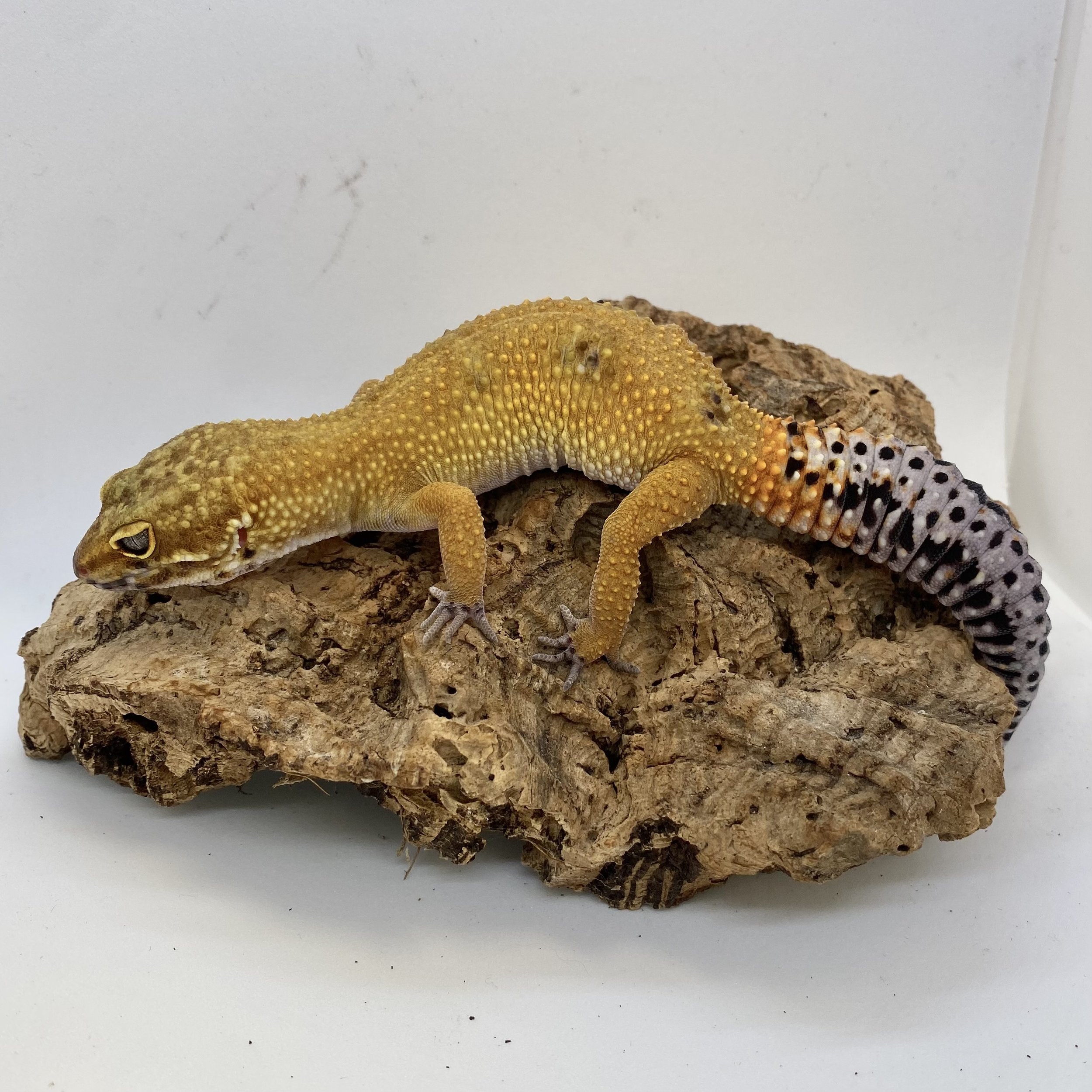
Leopard Gecko
Care
Lifespan
10 - 20 years on average.
Adult size
7 - 10 inches snout to tail, with Giants and Super Giants nearing 11 - 12 inches.
Housing
Our recommended minimum size requirement for an adult is a 3ft long Vivarium. Leopard Geckos can reach full size within a year to 18 months, so established babies and juveniles are often housed in their adult sized enclosure straight away. We recommend the use of 3 hides within the enclosure: 1 in the hot end, 1 in the middle and 1 moist hide (full of damp moss or soil) in the cold end.
The moist hide is especially important to aid in the shedding cycle. A sand/soil mix is the most recommended substrate within the enclosure to enable naturalistic behaviours. The risk of impaction is minimal as long as the basking temperatures are correct. Females may lay eggs with or without the presence of a male, so we recommend that a lay box is provided to allow mature females to dig and lay eggs correctly to avoid reproductive issues (egg- binding).
Heating
We recommend that the enclosure has a hot end and a cooler end to allow the Fat Tail to thermoregulate (control its own body temperature). On the hot side, it is recommended that a basking bulb is fitted to the ceiling of the vivarium with a ceramic lamp holder. We recommend the use of a dimming thermostat in conjuncture with the bulb to regulate temperatures to prevent overheating.
Once correctly set, this will dim and brighten the bulb to maintain the correct temperature during the daytime, which is 32-38C directly under the basking bulb (known as the hotspot), down to 20-24C in the cooler end.
Checking temperatures regularly is recommended to help catch fluctuations in temperatures. We recommend that lighting is on a 12 hour light cycle (for example 8am- 8pm) to replicate day and night.
However, if the vivarium drops below 17c at night, additional night time heating such as ceramic heaters or deep heat projectors is recommended that will raise night time temps without disturbing the day/night cycle. We recommend checking temperatures with reliable thermometers.
Lighting
UVB lighting is a beneficial option for this species. Benefits include aiding in the shedding cycle and aiding in the synthesis of calcium, therefore preventing Metabolic Bone Disease. If you choose to provide UVB lighting, we recommend us an Arcadia Shade Dweller UVB Kit fixed to the ceiling of the enclosure on the hot side.
Humidity
Leopard Geckos require low ambient humidity within the enclosure. However a moist hide is recommended filled of moss or soil which is kept damp and replaced when necessary. This aids in the gecko’s shedding cycle.
Water
We recommend that a fresh bowl of water is provided daily, and changed when dirty.
Diet
Leopard Geckos are insectivores so only eat insects. We recommend providing constant access to a mealworm dish as a grazing item and offer other live feeds once a day for babies and every 2-3 days for adults. We recommend that babies are fed 15-20 bugs a feed whilst adults 5-10, however this is only an approximation and should be adjusted based off of the animal’s metabolism. Staple live feeders include crickets and locusts with fatty options like Morios or wax worms being great treats.
Supplementation
We recommend the use of a calcium supplement used on food offered during weekdays (Monday-Friday) and a multivitamin used once a week on either a Saturday or Sunday (leaving a day of the weekend with no supplements used).
To supplement live food it is most recommended to add the amount of bugs being fed to a small plastic sandwich bag along with a small amount of the supplement, and then to gently shake the bag to lightly coat each insect before feeding.
Alternatively, if feeding a whole tub in one sitting, add ⅓ of a teaspoon of the supplement to the tub of bugs and gently shake. D3 supplements should be used if no UV lighting is provided to avoid metabolic bone disease however caution should be taken when using supplements with D3 as overdosing can cause neurological issues, thus we recommend just using UVB lighting.
Handling
Leopard Geckos have the ability to drop their tail, although this is not common. Once dropped the tail will regrow however not to the same look as it was before. This is a method of escape from predators, but can also happen if they are picked up by their tail, restrained, or feeling threatened. Babies tend to be faster and more nervous at first, but with regular gentle handling and interaction, they can become very calm and laid back adults.
